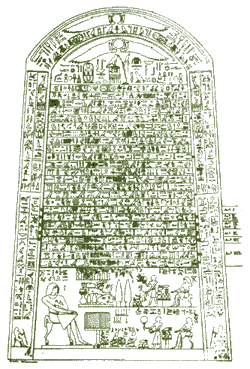 The world's earliest report of a dramatic production comes from the banks of the Nile. It is in the form of a stone tablet preserved in a German museum and contains the sketchy description of one, I-kher-nefert (or Ikhernofret), a representative of the Egyptian king, of the parts he played in a performance of the world's first recorded "Passion" Play somewhere around the year 2000 B.C. This Egyptian Passion bears a notable resemblance to the Passion Plays of the twentieth century. Its purpose is obviously the same as that of the one at Ober-Ammergau, or the Tyrolean, or the Persian Passion Play of Hussein . . . the principal object, as always, being to keep vivid in the minds of the faithful the sufferings and triumph of a god.
The world's earliest report of a dramatic production comes from the banks of the Nile. It is in the form of a stone tablet preserved in a German museum and contains the sketchy description of one, I-kher-nefert (or Ikhernofret), a representative of the Egyptian king, of the parts he played in a performance of the world's first recorded "Passion" Play somewhere around the year 2000 B.C. This Egyptian Passion bears a notable resemblance to the Passion Plays of the twentieth century. Its purpose is obviously the same as that of the one at Ober-Ammergau, or the Tyrolean, or the Persian Passion Play of Hussein . . . the principal object, as always, being to keep vivid in the minds of the faithful the sufferings and triumph of a god.
In the case of the Egyptian "Passion" the central figure was the legendary king-divinity, Osiris. According to the historical legend, Osiris ruled wisely. He was treacherously murdered and his body was cut in pieces and scattered. His wife, Isis, and his son, avenged his murder, gathered up the pieces of his body for pilgrimage relics, won back his throne and established the cult of Osiris-worship. We know that Passion plays in his memory were performed annually at Abydos, Busiris, Heliopolis, and elsewhere.
The acting of those days must certainly have been quite as realistic as that of any modern stage, for later Greek historians tell us that many actor-warriors died of the wounds received in the "sham" battles between the enemies of Osiris and the forces led by his son, Ap-uat. The play closes with the resurrection of Osiris as a god and the foreshadowing to all the faithful of their own final resurrection.
Purchase Books on Egyptian theatre